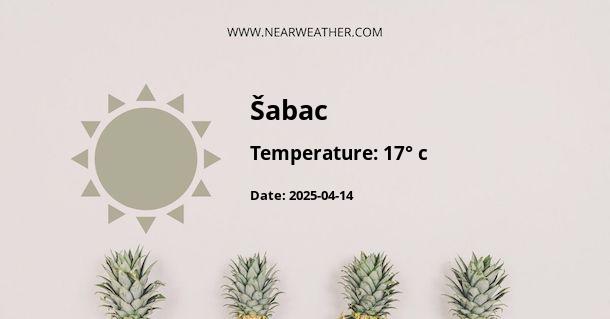Climate and Weather of Šabac, Serbia
Šabac, a city located in the western part of Serbia, experiences a continental climate with distinct seasons, each bringing its own meteorological characteristics. This detailed exploration into the climate and weather patterns of Šabac will offer insights into the city's average temperatures, precipitation levels, and seasonal variations that contribute to its unique weather profile.
Seasonal Climate Overview
The climate in Šabac is classified as Cfb according to the Köppen climate classification, indicating a temperate oceanic climate. However, due to its location away from large bodies of water and close proximity to the Pannonian Plain, its climate does exhibit certain continental characteristics.
Spring (March - May)
- Temperature: Spring in Šabac sees a gradual increase in temperatures, with average highs starting at around 12°C in March and reaching 22°C by the end of May.
- Precipitation: Rainfall is moderate, with the latter part of the season experiencing more frequent showers as the atmosphere becomes more unstable.
Summer (June - August)
- Temperature: Summers are warm with average high temperatures often exceeding 25°C. July is typically the hottest month with temperatures regularly reaching into the low 30s°C.
- Precipitation: Thunderstorms are common, contributing to higher rainfall totals, though the season is characteristically drier than spring.
- Sunshine: Šabac enjoys ample sunshine during the summer, averaging 10 to 11 hours of daylight.
Autumn (September - November)
- Temperature: Autumn witnesses a steady drop in temperatures, with September's highs around 24°C descending to 10°C by November.
- Precipitation: The season tends to be wetter as compared to the summer, with November often being the rainiest month of the year.
Winter (December - February)
- Temperature: Winters are cold with January being the coldest month when average low temperatures can drop below 0°C.
- Precipitation: Snow is possible, though major snowfall is not a common occurrence every year.
- Fog: The region may experience foggy conditions due to temperature inversions, particularly in January.
Monthly Climate Statistics
Note: The following averages provide a snapshot of what one might expect in terms of temperature and precipitation in Šabac throughout the year, based on historical data.
| Month | Average High (°C) | Average Low (°C) | Precipitation (mm) |
|---|---|---|---|
| January | 4 | -2 | 40 |
| February | 6 | -1 | 35 |
| March | 12 | 2 | 40 |
| April | 18 | 7 | 50 |
| May | 22 | 12 | 60 |
| June | 25 | 15 | 70 |
| July | 28 | 17 | 60 |
| August | 28 | 17 | 50 |
| September | 24 | 13 | 50 |
| October | 18 | 8 | 50 |
| November | 11 | 4 | 60 |
| December | 5 | 0 | 50 |
Extremes, Variations, and Notable Weather Events
While the above statistics provide an average, Šabac can experience weather extremes. In the summer months, temperatures can soar, leading to heatwaves where temperatures exceed 35°C. Conversely, winter can bring periods of bitter cold, with temperatures dropping significantly below freezing, sometimes accompanied by snowstorms.
Significant weather events, such as severe thunderstorms, hailstorms, and gusty winds, can occur with the passing of cold fronts or the development of low-pressure systems that regularly move across the region. Such events are more frequent during the transitional seasons of spring and autumn.
Meteorological Discussion and Predictive Analysis
Understanding the climactic trends and patterns in Šabac is essential for various sectors, including agriculture, urban planning, and tourism. Agriculture relies heavily on accurate seasonal forecasts to plan sowing and harvesting, making the most of the moderately wet and warm conditions prevalent in late spring through to the end of summer.
From a meteorological standpoint, the region of Šabac is influenced by its geographic position between the Sava River and the foothills of the Cer and Fruška Gora mountains. Topography plays a crucial role in local weather systems, contributing to microclimates that can differ slightly from the general patterns described.
Predictive models that consider long-term climate change projections suggest an increase in the intensity and frequency of extreme weather events in Šabac and surrounding regions. This includes hotter summers, milder winters, and potentially altering precipitation patterns. Urban planning and disaster management sectors are advised to integrate these predictive models into their strategies to mitigate the impacts of severe weather and climate change.
Conclusion
Šabac's weather and climate fit the typical continental template but with nuances brought by its regional topography and proximity to the Pannonian Plain. Seasonal variation in terms of temperature and precipitation is significant, and the city weather can range from cold, snowy winters to hot, stormy summers.
Residents and visitors alike can take advantage of the city's climate by participating in seasonal activities: enjoy the vibrant colors and comfortable conditions of spring and autumn, relax in the warm and sunny summers, or perhaps embrace the quiet and sometimes snowy landscapes of winter.
Understanding the climate and weather patterns of Šabac is essential for local planning and provides a solid foundation for a sustainable future in the face of a changing global climate. This comprehensive overview serves as a valuable guide for anyone interested in the climatology of this Serbian city.
A - Šabac's Latitude is 44.746670 & Longitude is 19.690001.
A - Weather in Šabac is 17° today.
A - Climate Conditions in Šabac shows overcast clouds today.
A - Humidity in Šabac is 51% today.
A - Wind speed in Šabac is 16.52 km/h, flowing at 248° wind direction. today.
